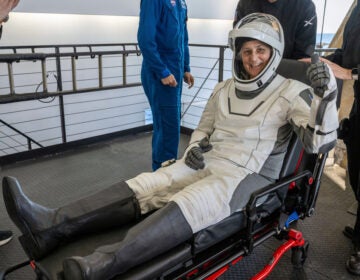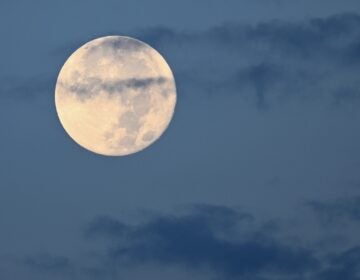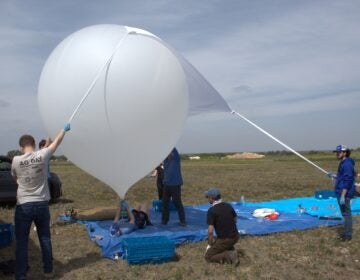A baker’s dozen (+1)
ListenA 14th moon of Neptune has been discovered and this one gets the prize for smallest size. Also, we’ll look back on the history at looking up at the night sky through the lens of a camera. And Derrick has tips for star gazers this week.
July 22, 2013
[Dave Heller] Let’s call it baker’s dozen plus one, at least until a better name comes along. Joining us to play the name-game is Derrick Pitts, chief astronomer at the Franklin Institute. Derrick, so many moons — how do we name them all?
[Derrick Pitts] It’s really a challenge. When we start to look at the outer planets of the solar system — Jupiter, Saturn, Uranus and Neptune — they often have so many moons it’s really difficult to name them all. There are naming conventions that are used, but in the case of Jupiter and Saturn, all the names are almost completely used up. So we give them numbers. In this case we’re talking about the fourteenth moon of Neptune, (“bakers dozen plus one,” this is the fourteenth moon of Neptune), and there hasn’t been assigned a name for this yet, but it’s been numbered S2004N1.
I like baker’s dozen better.
Yeah, that’s much more euphonious, and I can smell cinnamon already!
Is this body big enough to bake bread on?
It is big enough to bake bread on, but not by much. It’s only 12 miles in diameter, so that makes it about the smallest moon in the entire solar system. However, it could be that we might find other moons orbiting Neptune, it’s totally possible. The way that this particular moon was identified was that a scientist working at the SETI Institute was digging through data collected by the Hubble space telescope; photographs of Neptune between 2004 and 2009. In this data he found 150 photos of either the moon itself or its arch orbit around the planet. And with further examination and lots of calculation and additional digging, he determined that it is indeed a moon that hadn’t been seen before.
Last week we touched on the discovery of itty bitty moons around Pluto and now this week Neptune. These small bodies: Were they much once bigger and over the millennia have eroded down to this size, or you think that’s been fairly constant for the longest time?
I would probably think there’s a bit of both going on and a lot more of what I would describe as “forensic planetology” would have to be done to figure out what the situation is exactly with all of the moons around the solar system. Some we might be able to easily, definitively say that they are original to the planet or the original size. I mean even the case of our own moon; our own moon is a hybrid of some Earth material plus another body that came into this portion of the solar system, crashed into the Earth, and then spun off what we now know as the moon. So you might be able to say that our moon isn’t even original to this planet when our planet was formed. But as we look around we find even at Neptune there’s kind of an odd situation because its largest moon, Triton, which is 1,680 miles in diameter, obviously quite a bit bigger, actually rotates in the opposite direction of all the other moons. So the thinking is that perhaps Triton comes into the system around Neptune, scatters all of the other material that’s originally there, establishes this wrong-way orbit, and then other objects fall back into orbit but they’re heading the opposite way. So, again, we can’t just roll back the film and see what happened at the early history of the solar system, but if we dig around a little bit more, maybe we can figure out what happened.
-

This illustration is a composite of numerous separate Hubble WFC3 images. A color image composed of exposures made through three color filters shows the disk of Neptune, revealing clouds in its atmosphere. 48 separate images from a single filter were brightened to reveal the very faint moons. The white dots are Neptune’s inner moons moving along their orbits during Hubble’s observations. The solid green lines trace the full orbit of each moon. The spacing of the moon images follows the timing of each Hubble exposure. About 30 moons are known to orbit Neptune, most of which are too faint or orbit too far away to appear in these images. Illustration credit: NASA, ESA, and Z. Levay (STScI)
Well let’s roll back the history touching on the advent of astronomical forensic photography.
Yeah, that’s a lot easier because it wasn’t quite so long ago as the early history of the solar system or so far away as Neptune. It was about 163 years ago that William Cranch Bond took the first photograph of a star. The star in question was Vega and he used a process that had been invented by a French photographer called Daguerre. He used a process call the Daguerrotype to do this. Daguerre himself took a picture of the moon, or tried to take a picture of the moon in 1839. So that was really the earliest instance of trying to photograph an astronomical object and what’s most interesting about that is that it was just two years after Daguerre perfected the process of photography using this particular method that he used. He did that in 1837. So it seems like astronomy was an early target for the earliest photographers and still carries on today as not only an interesting aspect of photography, but certainly as one of the major tools of astronomy helping us to understand almost everything we’re trying to understand about the universe.
“Daguerre himself took a picture of the moon, or tried to take a picture of the moon in 1839. So that was really the earliest instance of trying to photograph an astronomical object.”
Derrick Pitts
-
Related: The Daguerreotype Process
Were these earliest efforts just pointing the lens at the sky, or was it done under magnification?
The earliest attempts were let’s just point the camera at the sky and see what we can get of specific objects. Trying to do Vega would eventually end up in trying to photograph it through a telescope so you could look at a discreet object. And from there on it was this sort of marriage, if you will, of these two technologies of the telescope and the camera. And the further addition of these two pieces was the spectrometer so that one could be able to take photographs of the spectrum of a star and thereby learn so much about the physical activity of the star. So putting these three pieces together really becomes one of the most important tools in astronomy and continues to this day as probably the most important tool in astronomy.
But to this day we still gain value from observing merely the visible part of the light spectrum?
It certainly is satisfying to have a beautiful, visible light image of astronomical objects. But you really need to look at the other portions of the electro-magnetic spectrum to derive real, useful information about astronomical objects.
Well let’s satisfy our curiosity by heading out of doors this week.
And we can pick what time we’d like to be out! If it’s cooler in the morning before sunrise, I suggest looking over toward the eastern horizon where 45 minutes before sunrise, particularly tomorrow morning, we’ll find Mars and Jupiter closely paired together over in the eastern sky. But if you prefer evening, we can still see Venus over the western horizon just after sunset, and Saturn over to the left of Venus, hanging in the south/southwestern sky for a good portion of the evening.
WHYY is your source for fact-based, in-depth journalism and information. As a nonprofit organization, we rely on financial support from readers like you. Please give today.




